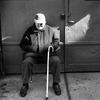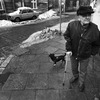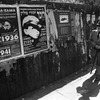Wyspianski Returns
After a year in the doldrums, the Stanislaw Wyspianski Museum finally reopened today in the newly renovated Szolajski House, a vast nineteenth century mansion at the heart of Cracow's Old Town.
The sudden disappearance of the museum over a year ago (when it was was rather ungraciously booted out of its prior home on Kanonicza street) caused something of a stir amongst Cracovians and Polish art specialists in general. After all, Kanonicza street, that enchanting stretch at the foot of the Royal Castle, was where the young Wyspianski had lived as a boy, and its proximity to the Wawel citadel leant it an all the more fitting resonance, given that the artist had derived so much inspiration from that national shrine, and had, indeed, developed a grand and sophisticated project for its regeneration in the last years of his life. With the blinking of an eye, the museum had vanished from its original home, amidst muddled talk of increased rents. Those visitors who trundled down to No. 9 Kanonicza in search of the museum were greeted by a placard announcing a new private school on the premises, owned, as it was, by the goodly Mayor of Cracow.
However, any notions that the reshuffle was an unnecessary fiasco hold little sway in the light of today's reopening. The new museum is a marvelous achievement - a fitting tribute to a figure who is arguably Poland's greatest artist.
In fact, for all the beauty of its contents and the charm of their location, those that knew the museum in its previous form will remember a somewhat claustrophobic, melancholic place. It always seemed rather dark and forlorn, with small, poorly lit rooms that were not at all well-suited to exhibiting such a wide range of art. These morose qualities were certainly not unCracovian in character, but somehow you felt that Wyspianski deserved better.
Then, in 2002, the collection of medieval Polish art that was housed in the Szolajski house was earmarked for a former bishop's palace opposite the Hotel Copernicus, and an ambitious programme of renovation was set in motion to house the new Wyspianski. The results are spectacular, and today's Wyspianski seems a world away from the staid flakiness that is characteristic of so many of Cracow's museums, many of which have changed little since the Cold War days.
The Szolajski House is indeed remarkably well-suited to the purposes of a museum. Really more a palace than a house, it stretches a good halfway across the eastern side of Szczepanski Square, with a grand interior that forms a square around a large inner courtyard. The interior has been graciously restored, with a simple but elegant wooden stairwell, and a restful shade of yellow on the walls. The stairs are lined with Ignacy Krieger's black and white pictures of Cracow during the late nineteenth century, providing a glimpse of the city as Wyspianski knew it.
The collection itself resides on the first and second floors, and is arranged in two chains of rooms, one above the other. These grand, spacious rooms have been marvelously restored, and where possible, new life has been breathed into the dainty nineteenth century polychromy that the architects discovered during restoration. As a result, a very typical Cracovian grandeur provides a backdrop to much of the collection. And, owing to the traditional classical harmony of these old murals, this is never so intrusive as to be detrimental to the collection itself. In fact, the presence of these decorative flourishes lends the museum a more homely air than is usually found in the cold, monotone interiors of so many European galleries. Meanwhile, aristocratic sized windows and modern interior lighting ensure that full justice has been done to the exhibits themselves.
Thematically, the collection has been divided up in much the same way as before. One begins with sketches and paintings from the artist's youth, heading on through his early, traditional designs under the wing of Jan Matejko, the grand old man of nineteenth century Polish painting, who had employed Wyspianski as one of his pupils during the regeneration of the historic church of St. Mary's. One heads on through Wyspianski's eccentric experiments in furniture (some of which succeeded rather better than others it must be said!) and on into his magnificent pastel portraits, and then to the highly original designs for the stained glass windows of the Medical Society and the Franciscan Church.
As one enters the rooms devoted to drama, stage and costume design, the astonishing diversity of this artist really begins to hit home. Here, after all, was a man who not only reinvented the stained-glass window, who could draw with the compassion and intensity of a master, but who was also able to write some of the most moving and best-loved plays in the Polish language. Wyspianski took Polish theatre by the lapel, and thrust it forward into modernity.
On the top floor, his grand designs for the regeneration of the Wawel Hill citadel are given marvelous expression in the large, impeccably designed model. (One can't help feeling that it was something of a shame that the project was never realized, but war, combined with Wyspianski's own deteriorating health - he died at the meagre age of 38 - put paid to such plans.
Some thirty or so works are included in the exhibition that have never been shown before. Nevertheless, it is certainly true to say that nothing original has been done in terms of thematic arrangement. However, the chain of rooms on the ground floor has already proved to be a marvelous forum for hosting related exhibitions.
At the Szolajski House, Wyspianski's art can now be savoured in gracious, serene and well lit surroundings. It has indeed set the standard for museums in Cracow, with an arrangement that deftly dovetails classic and modern design. All things considered, the difference between the old and the new Wyspianski could be likened to that of watching a classic film on a old video player, or sitting back in a state of the art cinema in a refurbished fin-de-siecle theatre. A toast then to the mayor and his new school on Kanonicza.

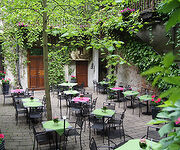 Kawaleria Szarza Smaku
Kawaleria Szarza Smaku
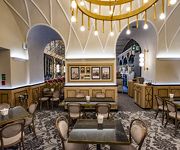 Europejska
Europejska
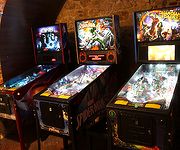 Krakow Pinball Museum
Krakow Pinball Museum



